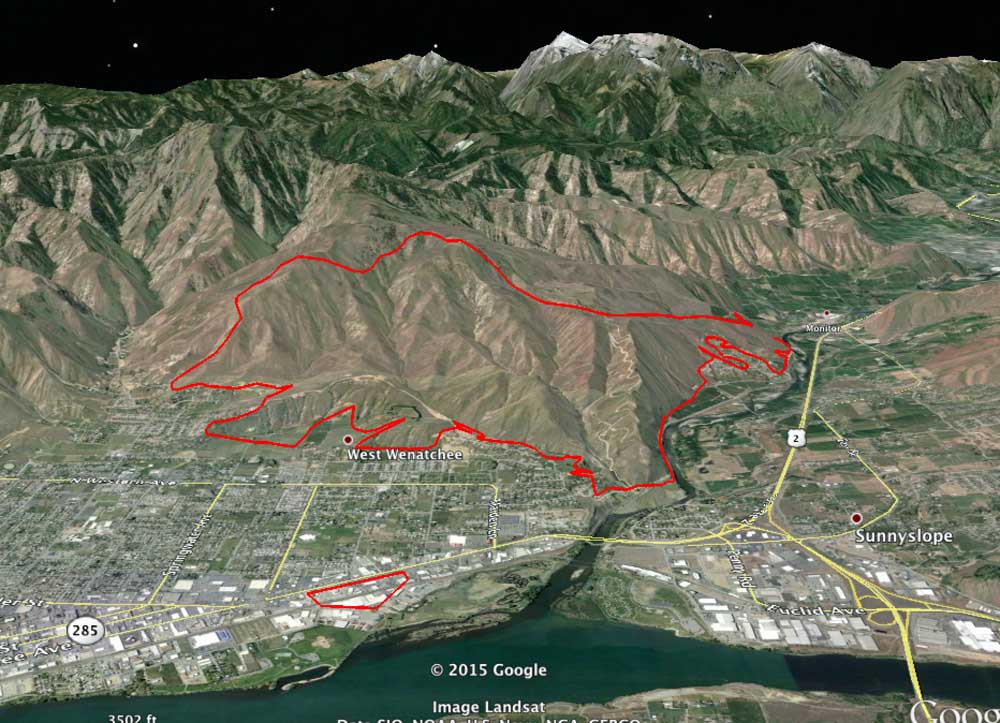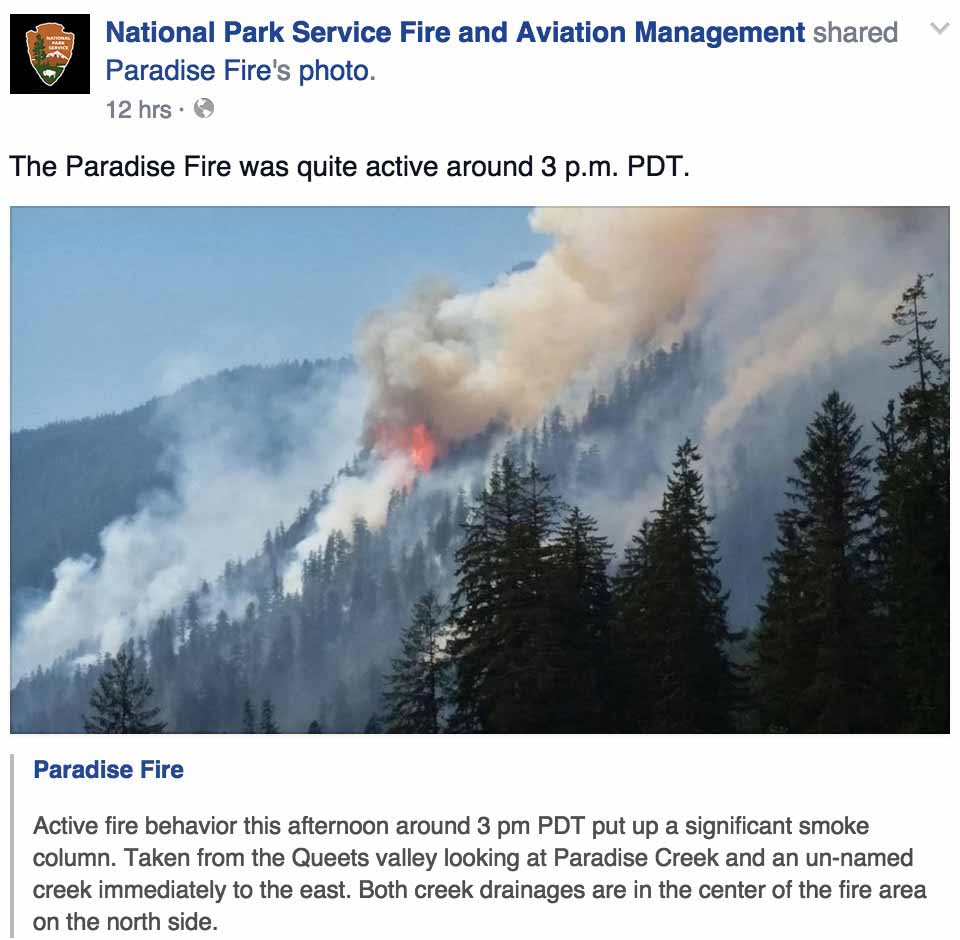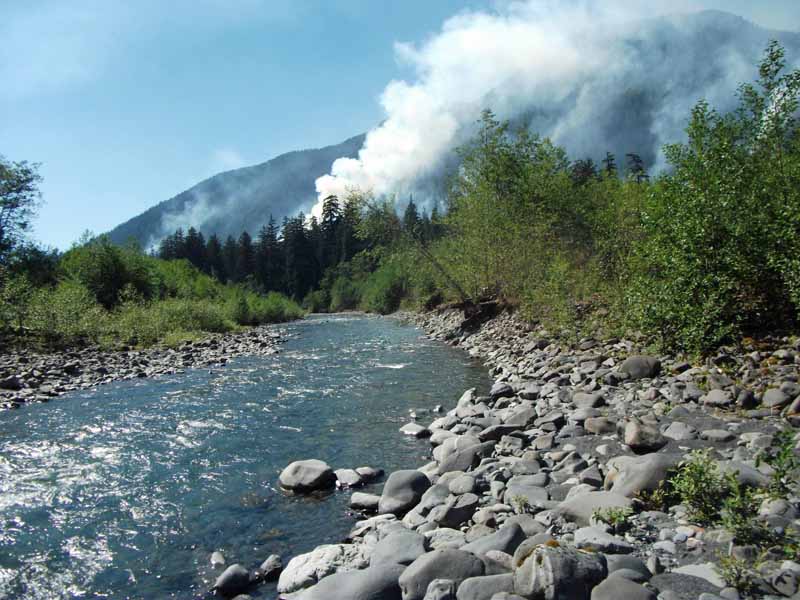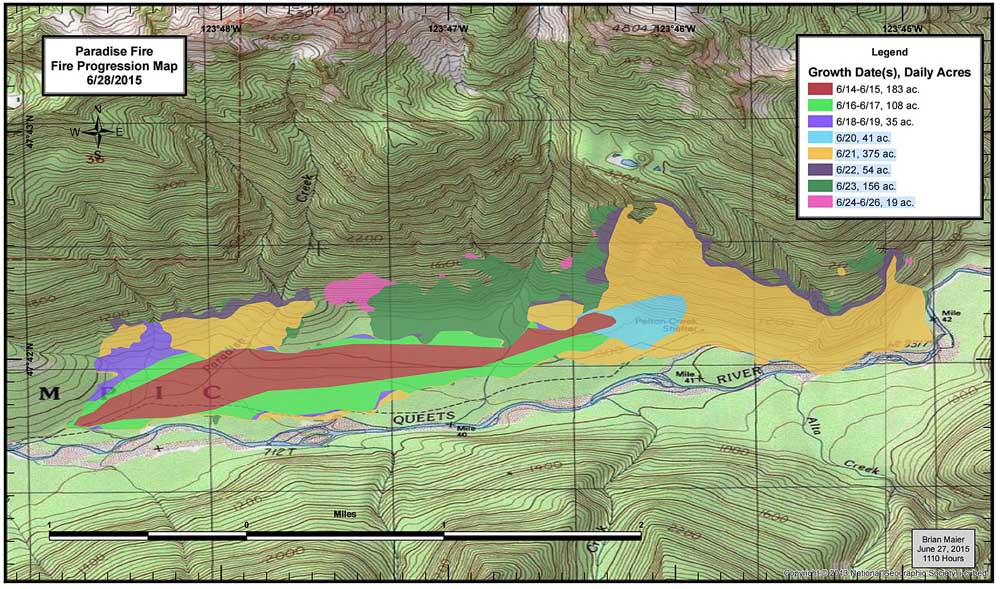(UPDATED at 7:32 p.m. PT, July 1, 2015)

The map above is a 3-D map of the Sleepy Hollow Fire in central Washington, looking west, produced after a mapping flight at 1 a.m. PT, July 1.
One interesting thing is the spot fire that caused several businesses to burn near the river. It was 1.2 miles away from the main fire. This is not unheard of, for a burning ember to travel that far and ignite a new fire. It has happened over much greater distances.
A recent example was on the King Fire in northern California in 2014 — a spot fire occurred 2 miles in front of the main fire.
****
(UPDATED at 10:58 a.m. PT, June 30, 2015)
The Sleepy Hollow Fire 95 air miles east of Seattle has been mapped at 2,995 acres. The incident commander, according to @jwhittenbergK5, confirms that 24 residences burned.
Heavy rain Sunday evening stopped the spread of the fire, however the industrial facilities continued to burn.
****
(UPDATED at 9:38 p.m. PT, June 29, 2015)
Fire officials are reported at 3:35 p.m. on Monday that the Sleepy Hollow Fire that spread into Wenatchee, Washington burned 24 to 28 residences, and that a more accurate count will be available when fire crews are able to access the entire burned area. They are estimating the size at 4,000 acres.
Wenatchee is in central Washington, 95 air miles miles east of Seattle.
Approximately four businesses also burned, some of which were about a mile from the main fire. The suspicion is that burning embers landed in some bales of cardboard that were being recycled and that fire spread into the industrial structures.
****
(UPDATED at 4:03 PT, June 29, 2015)
The Wenatchee World has a gallery of photos showing the neighborhoods that burned.
Rain on Monday, heavy in some areas, will make the job of firefighters much easier. The precipitation even caused a mud slide that closed Highway 2 near the mouth of Pine Canyon shortly after 3 p.m.
****
(UPDATED at 11:42 a.m. PT, June 29, 2015)
As you will hear in the video above, the number of structures burned in the Sleepy Hollow Fire in Wenatchee, Washington has been revised upward, from 24 to 28.
****
(UPDATED at 9:30 a.m. PT, June 29, 2015; originally published at 8:53 a.m. PT, June 29, 2015)
Approximately 24 structures have burned in a rapidly spreading wildfire in Wenatchee, Washington, reports Jake Whittenberg of King 5 News. The Sleepy Hollow Fire started Sunday afternoon, June 29 and by Monday morning had burned 3,000 acres. The number of structures destroyed could change as firefighters are able to get a better look at the damage caused by the fire in central Washington 95 miles east of Seattle. More than 1,000 people have been forced to evacuate, including a Walmart store in the north part of town.
Strong winds on Monday afternoon and triple-digit temperatures helped spread the fire quickly from where it started three miles west of town through sage and grass into a “pretty dense urban interface area”, said deputy state fire marshal Bill Slosson.
Some of the structures that burned were warehouses and fruit packing plants. Monday morning smoke was still coming from the facilities of Michelsen Packaging Company, Northwest Wholesale, and Blue Bird Inc.
“The city is asking residents to severely curtail water use”, Carl Buick, who lives nearby, told Wildfire Today. “This is significant because we have a robust water system and supply. The reservoirs have been severely drawn down.”
The fire was still very active through Sunday night, but firefighters hoped rain falling Monday morning would help them corral the devastating fire.
A weather station 14 miles north of the fire recorded 0.01″ of rain at 7:24 a.m. Monday morning, but there was a report of heavier rain at the fire. That same station reported a high temperature of 111 degrees on Sunday. Most of Washington, including the Wenatchee area, is under a Red Flag Warning on Monday for gusty winds and the possibility of dry lightning, which could ignite more fires.
The video below is from a Sunday night newscast.
A Type 2 incident management team has been ordered.
Skyking captured the devastation on Broadview in Wenatchee. 24 structures lost. #SleepyHollowFire @KING5Seattle pic.twitter.com/ePwvHMy7IO
— JakeWhittenberg (@jwhittenbergK5) June 29, 2015
At least 12 homes destroyed in Wenatchee fire. So sad. | via @KING5Seattle: http://t.co/w28H2eW7m1 pic.twitter.com/QruIgpWiU1 — Susie Rantz (@SusieRants) June 29, 2015








